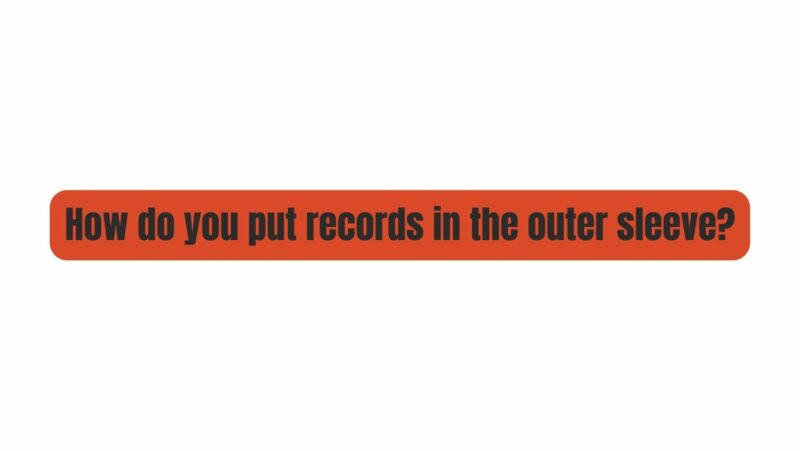Vinyl records, with their timeless charm and rich analog sound, have maintained a devoted following for decades. As collectors and enthusiasts alike continue to embrace the vinyl resurgence, the importance of proper care and maintenance cannot be overstated. One essential aspect of vinyl record care is knowing how to correctly store records in outer sleeves. In this in-depth guide, we will explore the significance of outer sleeves, the materials and types available, and provide step-by-step instructions on how to properly protect your cherished vinyl records for the long term.
The Role of Outer Sleeves
Outer sleeves, also known as record sleeves or jacket covers, play a crucial role in safeguarding the condition and longevity of your vinyl records. Here’s why they are so important:
- Dust and Debris Protection: Outer sleeves provide a physical barrier that shields records from dust, dirt, and other airborne particles. This protection is vital for maintaining the cleanliness of the record surface and the playback quality.
- Preventing Ring Wear: Ring wear, the circular wear pattern that appears on album covers over time, can also affect the vinyl record itself if it’s not adequately protected. Outer sleeves guard against this type of wear by creating a buffer between the record and the cover.
- Minimizing Seam Splits: Outer sleeves help prevent seam splits, which occur along the edges of album covers due to repeated handling and storage. These splits can affect the overall aesthetics of the record cover.
- Handling and Preservation: Handling vinyl records without outer sleeves can lead to fingerprints, smudges, and even accidental spills. Outer sleeves reduce the risk of such mishaps and ensure the record cover’s longevity.
Choosing the Right Outer Sleeves
Before you begin storing your vinyl records in outer sleeves, it’s essential to choose the right type and material. Outer sleeves are available in various options, including:
- Polyethylene (Poly) Sleeves: These are the most common type of outer sleeves and are widely used among vinyl collectors. Poly sleeves are affordable, transparent, and offer excellent protection against dust and debris. They are available in various thicknesses, with thicker sleeves providing better durability.
- Polypropylene Sleeves: Similar to polyethylene sleeves, polypropylene sleeves are transparent and provide good protection. They are often considered a slightly more rigid and durable option compared to polyethylene.
- Paper Sleeves with Poly Lining: These sleeves consist of a paper exterior with a poly lining. They offer a vintage look while providing the benefits of both paper and poly. However, they may not be as clear as fully transparent options.
- Anti-Static Sleeves: These sleeves are specially designed to reduce static buildup, which can attract dust and debris to the record surface. Anti-static sleeves are an excellent choice for preserving audio quality.
- Gatefold Sleeves: Gatefold sleeves are designed for double albums or records with gatefold covers. They offer a wider opening to accommodate the larger size and often have a clear section to display the album cover artwork.
Selecting the right outer sleeves depends on your preferences, budget, and the level of protection you desire for your vinyl records. Whichever type you choose, ensure that they are acid-free and archival quality to prevent any chemical reactions that could damage the record covers over time.
Step-by-Step Guide to Storing Records in Outer Sleeves
Now that you’ve selected the appropriate outer sleeves for your vinyl records, let’s go through the step-by-step process of properly storing your records in these protective covers:
Step 1: Prepare a Clean Workspace
Start by clearing a clean, flat surface where you can work. Ensure that the area is free from dust, liquids, or any potential hazards that could harm your records.
Step 2: Wash Your Hands
Before handling your vinyl records or outer sleeves, wash your hands thoroughly to remove any oils, dirt, or residue that could transfer onto the records or covers.
Step 3: Remove the Record from the Inner Sleeve
Gently remove the vinyl record from its inner sleeve by holding it on the edges, taking care not to touch the playing surface. Place the inner sleeve aside.
Step 4: Inspect the Record
Take a moment to inspect the record for any visible dust or debris. If you notice any, use a carbon fiber brush or an anti-static brush to gently remove the particles. Brush from the center of the record outward to avoid pushing debris into the grooves.
Step 5: Open the Outer Sleeve
Lay the outer sleeve flat with the opening facing up. Carefully open the outer sleeve, taking care not to bend or crease it. Some outer sleeves have a flap at the top for easy access.
Step 6: Slide the Record into the Outer Sleeve
Hold the vinyl record by its edges and gently slide it into the open outer sleeve. Ensure that the record is fully inserted and centered within the sleeve. Make sure the album cover aligns with the outer sleeve’s front.
Step 7: Seal the Outer Sleeve
If your outer sleeve has a resealable flap, gently fold it over to seal the sleeve. If not, you can use resealable adhesive strips designed for this purpose to secure the sleeve shut. Ensure that the sleeve is snug but not too tight.
Step 8: Store Vertically
Place the record back in your storage shelf or crate vertically. Storing records vertically prevents warping and ensures that they remain in good condition.
Conclusion
Properly storing your vinyl records in outer sleeves is an essential step in preserving the condition and longevity of your beloved collection. Outer sleeves provide a protective shield against dust, debris, and the wear and tear of regular handling. By following the step-by-step guide and selecting the right type of outer sleeves, you can ensure that your vinyl records remain in pristine condition, both in terms of audio quality and aesthetics. Remember that the effort you invest in vinyl care pays off in the form of an enhanced listening experience and the long-term enjoyment of your vinyl treasures.


